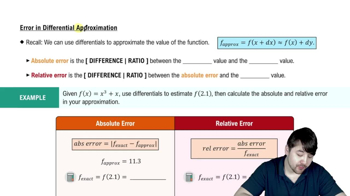Table of contents
- 0. Functions7h 52m
- Introduction to Functions16m
- Piecewise Functions10m
- Properties of Functions9m
- Common Functions1h 8m
- Transformations5m
- Combining Functions27m
- Exponent rules32m
- Exponential Functions28m
- Logarithmic Functions24m
- Properties of Logarithms34m
- Exponential & Logarithmic Equations35m
- Introduction to Trigonometric Functions38m
- Graphs of Trigonometric Functions44m
- Trigonometric Identities47m
- Inverse Trigonometric Functions48m
- 1. Limits and Continuity2h 2m
- 2. Intro to Derivatives1h 33m
- 3. Techniques of Differentiation3h 18m
- 4. Applications of Derivatives2h 38m
- 5. Graphical Applications of Derivatives6h 2m
- 6. Derivatives of Inverse, Exponential, & Logarithmic Functions2h 37m
- 7. Antiderivatives & Indefinite Integrals1h 26m
- 8. Definite Integrals4h 44m
- 9. Graphical Applications of Integrals2h 27m
- 10. Physics Applications of Integrals 2h 22m
4. Applications of Derivatives
Differentials
Problem 4.8.51
Textbook Question
{Use of Tech} Fixed points An important question about many functions concerns the existence and location of fixed points. A fixed point of f is a value of x that satisfies the equation f(x) = x; it corresponds to a point at which the graph of f intersects the line y = x. Find all the fixed points of the following functions. Use preliminary analysis and graphing to determine good initial approximations.
f(x) = 2x cos x on [0,2]
 Verified step by step guidance
Verified step by step guidance1
Understand the concept of a fixed point: A fixed point of a function f(x) is a value x such that f(x) = x. This means the graph of f(x) intersects the line y = x at this point.
Set up the equation for fixed points: For the function f(x) = 2x cos(x), we need to solve the equation 2x cos(x) = x. This simplifies to 2x cos(x) - x = 0.
Factor the equation: The equation can be rewritten as x(2 cos(x) - 1) = 0. This gives us two potential solutions: x = 0 or 2 cos(x) - 1 = 0.
Solve the equation 2 cos(x) - 1 = 0: This simplifies to cos(x) = 1/2. Determine the values of x within the interval [0, 2] that satisfy this equation.
Use graphing or numerical methods to approximate solutions: Graph the function f(x) = 2x cos(x) and the line y = x on the interval [0, 2] to visually identify points of intersection. Alternatively, use numerical methods like the bisection method or Newton's method to find more precise values of x where f(x) = x.
 Verified video answer for a similar problem:
Verified video answer for a similar problem:This video solution was recommended by our tutors as helpful for the problem above
Video duration:
2mPlay a video:
Was this helpful?
Key Concepts
Here are the essential concepts you must grasp in order to answer the question correctly.
Fixed Points
A fixed point of a function f is a value x such that f(x) = x. This means that at this point, the output of the function equals the input. Graphically, fixed points are where the graph of the function intersects the line y = x. Identifying fixed points is crucial in various applications, including iterative methods and stability analysis.
Recommended video:

Critical Points
Graphing Functions
Graphing functions involves plotting the function on a coordinate plane to visualize its behavior. This technique helps in identifying key features such as intercepts, maxima, minima, and fixed points. For the function f(x) = 2x cos x, graphing can provide insights into where the function intersects the line y = x, aiding in the approximation of fixed points.
Recommended video:

Graph of Sine and Cosine Function
Preliminary Analysis
Preliminary analysis refers to the initial examination of a function's properties, such as continuity, differentiability, and behavior over a specified interval. For the function f(x) = 2x cos x on [0, 2], this analysis can help determine the likelihood of fixed points existing within that range and guide the selection of initial approximations for further numerical methods.
Recommended video:

Derivatives Applied To Velocity







